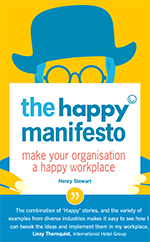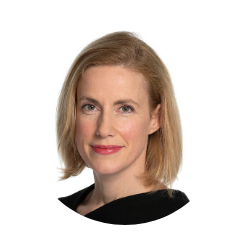How Sky UK's HR Department has Embraced Design Thinking
At Sky UK, they have embraced Design Thinking to tackle common HR issues. Design Thinking is a methodology that provides a solution-based, human approach to problems. It aims to create multiple ideas during brainstorming, which can then be prototyped and tested in a empathetic way that people can easily understand. For Sky, in the final stage, they test people's reactions and gauge if it 'wows'.
In this short video from the 2019 Happy Workplaces Conference, Tracey Waters explains how they applied Design Thinking to the question 'how might we help people at Sky have a fulfilling career?'
Hi, we are Happy
We are leading a movement to create happy, empowered and productive workplaces.
How can we help you and your people to find joy in at least 80% of your work?
How Sky UK's HR Department has Embraced Design Thinking
We embraced design thinking, which is about problem finding and you always start design thinking with a really great question.
And if there’s one nickable you take today it would be any question that starts with ‘how might we…’ almost certainly will get a different conversation than if you started it with ‘what can we…’ ‘How’ is action focused, rather than ‘what’, which is a thing or a noun. ‘Might’ is an openness to possibility – we don’t know the answer – whereas ‘can’ is a capability question. And ‘we’ is about collaboration. ‘How might we?’ opens up the conversation.
So we went after the question, ‘how might we help people at Sky have a fulfilling career?’ It’s a big, bold question, but we went after it. And what my team did is then embrace the design thinking model – what is, what if, what wows, what works? I’ll take you through. This started in February, so it’s hot off the press.
So what they did with ‘what is’ – ‘what is’ is where you actually go and talk to people about what, in this case, career means to them. What they think the obstacles are, what has helped them in their career, where they feel it’s been easy and where it’s been difficult. My team, in eight workdays, spoke to 25 employees. New starters, people who were leaving or had left Sky, people who had been there for five years, 10 years, 20 years. They spoke to them face to face, in person, for 90 minutes.
The thing that we were stunned by is that, I don’t know about you but Sky have a back-to-back meeting culture – to get time into people’s diaries you need about six weeks notice. People fell over themselves to give 90 minutes of their diary to talk about this. What does that tell you about this topic? It’s really, really important to people. We found out their pain points, we found out their motivations, we understood that career actually means about eight different things to people. And if we didn’t ask those questions, again we probably would’ve solved the wrong problem.
The second thing that we then did was go after ‘what if?’ This is where actually and importantly you get employees, our people, involved in the brainstorming. They actually come in and help us with the creative thinking. This whole way through the design thinking the principle is co-creation. HR doesn’t have to have the answers. We don’t have to know what the right thing is. The best way that we’re going to solve it is by asking our people to help us solve it for them, because this is about solving something for the employee for the person, not for HR. That’s a really key difference.
The third thing: ‘what wows?’ What the team then does is take all of this data and all of this insight and comes up with four ideas that it thinks people will actually respond well to, it thinks that people will go ‘wow.’ And it might do it up as a drawing, I think they did one of them up as Lego, it doesn’t matter, it’s to try and represent the idea. And then again they go back and they go, ‘I want to present this idea to you,’ and they’re not actually really that interested in what the person says. What do you think they’re looking at? Their reaction.
So if I show you an idea, what will your face do immediately? It’ll either light up and go, ‘wow, that’s a great idea,’ or they’ll do this [feigns look of ambivalence]. And if they do that, then we probably haven’t quite nailed the idea. But in this instance what we’re doing is we’re presenting an idea. It’s really risky – people don’t actually like presenting ideas for critique, so it is quite a bold and brave move – but what they’re looking for is what they look like, what their body language is, because remember what employee experience is about is delighting people, creating a real wow experience. And again design thinking allows you again to go through that process.
"If there's one nickable you take today it would be any question that starts with 'how might we...' almost certainly will get a different conversation than if you started it with 'what can we...'," explained Tracey Walters of Sky UK at the 2019 Happy Workplaces Conference.
'How' is action-focused, 'might' is an openness to possibility, 'can' is a capability question, and 'we' is about collaboration. Tracey has found that this opens up the conversation to future possibilities.
Using Design Thinking, at Sky they have been exploring the question 'how might we help people at Sky have a fulfilling career?'
This method uses four different questions:
- 'What is' — this involves talking to people about what this means to them. In this case, what the obstacles have been and what has helped them in their career.
- 'What if' — this involves employees in the brainstorming process and asks them to help come up with ideas.
- 'What wows' — the team then comes up with four of the best ideas, and presents these ideas back to staff. They then watch their reaction — only if they light up and go 'wow, that's a great idea!' does it go onto the next phase of the process.
- 'What works' — in the final phase, the best idea is made into a prototype or a trial for a small number of the team, as a minimum viable product, and then refined and tweaked as time goes on.
"We've done a lot with very little, which makes it so accessible to so many companies and HR teams," explains Tracey.
Resources and related content
- Why a Non-Profit Scrapped Their Appraisals Process — Rather than using an annual appraisal to give staff feedback, embed a coaching culture in your organisation. "You can give effective coaching and feedback regularly, in short discussions, to help people come to their own conclusions on their performance," explains Sophie Bryan. Could you implement this in your HR department?
- 9 Great Companies That Practice Collaborative Hiring — In 2016, the BBC ran a new TV series called 'Who's the Boss?' which allowed a wide range of staff to be involved in deciding who to employ. The process gets away from individual bias, the potential recruits get a much better sense of the business and people feel really involved in the decision.
- 12 Ways in Which Toyota Create a Great Workplace — Henry Stewart visited Toyota and learned about 'kaizen'. Each member of staff is expected to come up with at least two kaizen, or improvements, each month. They are allocated 15 minutes a day to identify and test these.
- Leading in Agile Environments — Happy has partnered with Adventures in Agile to offer this two-day transformational workshop to develop leaders driven by purpose, creativity, curiosity, and empathy.
Keep informed about happy workplaces
Sign up to Henry's monthly Happy Manifesto newsletter, full of tips and inspiration to help you to create a happy, engaged workplace.

Learn the 10 core principles to create a happy and productive workplace in Henry Stewart's book, The Happy Manifesto.
About Tracey Waters
Tracey is Head of People Experience and Development at Sky UK. Her experience in learning, leadership and talent spans nearly 15 years.
She is on a mission to help Sky become a twenty-first century organisation and is a passionate advocate of utilising Agile to achieve this.
She has a Master’s degree in Clinical Psychology, and has worked in telecoms, mining, transport and logistics in Australia and the UK.
Next Conference: 2025 Happy Workplaces Conference
Our Happy Workplaces Conference is our biggest event of the year, and we'd love for you to join us on Thursday 12th June!
This year's event will be held at Happy's HQ in Aldgate, central London.
We may also offer a hybrid option for people to join us online simultaneously — do let us know if you are interested in joining online and we can add you to the waiting list.
As always, our next conference will be filled with interaction, discussion and space for reflection.
Related courses
The Happy Leadership Programme
Brave Leadership: One-Year Leadership Development Programme for Women
Level 7 Senior Leadership Apprenticeship Programme
Not what you need? Take a look at all of our off-the-shelf Leadership and Management programmes.
